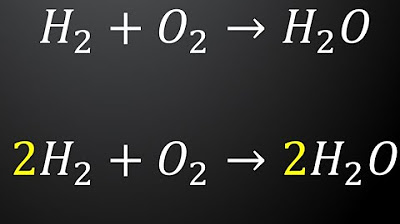Balancing chemical equations | Chemical reactions | High school chemistry | Khan Academy
Summary
TLDRThis script explains the concept of balancing chemical equations in chemistry. It uses the example of aluminum reacting with dioxygen to form aluminum oxide, demonstrating how to ensure equal numbers of each atom on both sides of the equation. The process involves multiplying the reactants and products by whole numbers to achieve balance, avoiding fractions and emphasizing the importance of whole number molecules.
Takeaways
- 🔬 Balancing chemical equations is a fundamental concept in chemistry that can be understood with a methodical approach.
- ⚗️ A chemical equation represents a chemical reaction, describing the reactants and products involved.
- 🧪 In the given example, aluminum reacts with dioxygen (O2) to form aluminum oxide (Al2O3).
- ⚖️ Balancing a chemical equation ensures the same number of each type of atom on both sides of the equation.
- 🔄 Initially, the unbalanced equation shows one aluminum atom on the reactant side and two on the product side.
- 🧮 To balance the aluminums, the coefficient in front of aluminum on the reactant side is adjusted to 2.
- 🌐 The oxygens are initially unbalanced with two atoms on the reactant side and three on the product side.
- ➗ Multiplying by 1.5 balances the oxygens, but fractional molecules are not preferred in chemical equations.
- ✖️ Multiplying all coefficients by 2 converts fractional coefficients to whole numbers, resulting in 4 Al + 3 O2 → 2 Al2O3.
- 🔍 The final balanced equation has four aluminum atoms and six oxygen atoms on both sides, confirming its balance.
Q & A
What is a chemical equation?
-A chemical equation is a symbolic representation of a chemical reaction, showing the reactants on the left and the products on the right, with the respective chemical formulas and coefficients indicating the quantities involved.
Why is it necessary to balance chemical equations?
-Balancing chemical equations is necessary to ensure that the number of atoms of each element is the same on both sides of the equation, adhering to the law of conservation of mass, which states that matter cannot be created or destroyed in a chemical reaction.
What is the initial imbalance in the example of aluminum reacting with dioxygen?
-Initially, the imbalance is that there is one aluminum atom on the left side and two aluminum atoms on the right side in the aluminum oxide molecule, and two oxygen atoms on the left side as a dioxygen molecule versus three oxygen atoms on the right side in the aluminum oxide molecule.
How can you start balancing the aluminum atoms in the given chemical equation?
-You can start by placing a coefficient of 2 in front of the aluminum on the left side of the equation to match the two aluminum atoms in the aluminum oxide molecule on the right side.
What is the issue with simply multiplying the dioxygen molecule by 1.5 to balance the oxygen atoms?
-The issue is that in chemistry, we prefer whole number molecules rather than fractions or decimals, as it is not practical to have a half molecule in a chemical reaction.
How did the speaker resolve the issue of having 1.5 molecules of dioxygen?
-The speaker resolved the issue by multiplying both sides of the equation by 2, which is the smallest whole number that can eliminate the fraction and result in whole number molecules.
What is the final balanced chemical equation for the reaction between aluminum and dioxygen?
-The final balanced chemical equation is 4Al + 3O2 → 2Al2O3, indicating that four aluminum atoms react with three dioxygen molecules to produce two molecules of aluminum oxide.
What is the significance of using whole number coefficients in chemical equations?
-Using whole number coefficients ensures that the law of conservation of mass is followed, as it represents the actual physical quantities of molecules that participate in the reaction.
Can you have a fraction or decimal as a coefficient in a balanced chemical equation?
-Ideally, no. Fractions or decimals as coefficients are not preferred because they do not represent the discrete nature of molecules in a chemical reaction.
What is the role of the implicit '1' in the chemical equation before multiplying by two?
-The implicit '1' represents the stoichiometric coefficient for the reactants and products that are not explicitly shown with a coefficient. It is assumed to be '1' unless otherwise stated.
How can you verify that a chemical equation is balanced?
-You can verify that a chemical equation is balanced by counting the number of atoms of each element on both sides of the equation and ensuring they are equal.
Outlines

هذا القسم متوفر فقط للمشتركين. يرجى الترقية للوصول إلى هذه الميزة.
قم بالترقية الآنMindmap

هذا القسم متوفر فقط للمشتركين. يرجى الترقية للوصول إلى هذه الميزة.
قم بالترقية الآنKeywords

هذا القسم متوفر فقط للمشتركين. يرجى الترقية للوصول إلى هذه الميزة.
قم بالترقية الآنHighlights

هذا القسم متوفر فقط للمشتركين. يرجى الترقية للوصول إلى هذه الميزة.
قم بالترقية الآنTranscripts

هذا القسم متوفر فقط للمشتركين. يرجى الترقية للوصول إلى هذه الميزة.
قم بالترقية الآنتصفح المزيد من مقاطع الفيديو ذات الصلة

Persamaan Reaksi Kimia dan Cara Mudah Menyetarakan Reaksi Kimia

GCSE Chemistry - Balancing Chemical Equations #4

Persamaan reaksi dan penyetaraan reaksi kimia - Kimia SMA kelas 10 semester 2

R2.1.1 Balancing chemical equations

Chemistry: Balancing Chemical Equations (Tagalog Explained)

Balancing Chemical Equations
5.0 / 5 (0 votes)
